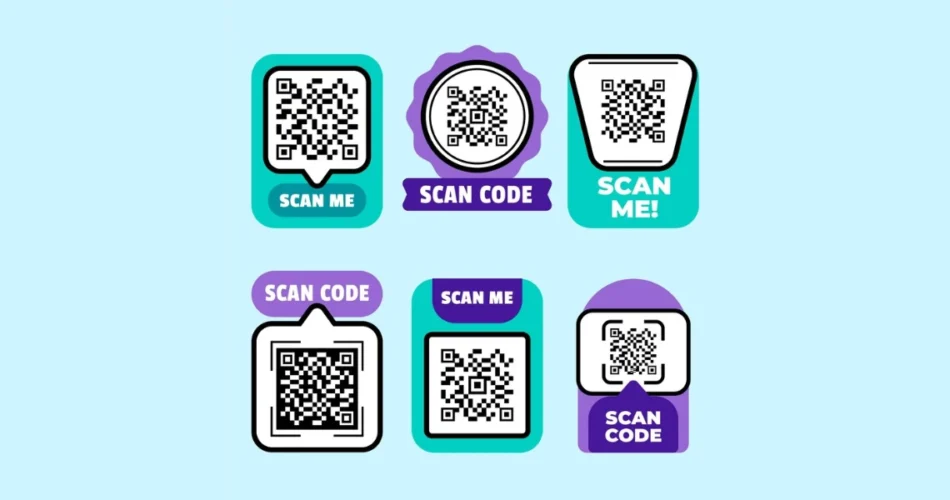Most of you reading this article are aware of what QR Codes are.
For the uninitiated, QR Code, or Quick Response Code, is a two-dimensional matrix barcode that can store various information.
It was first developed in Japan in the 1990s for tracking automotive parts during the manufacturing process.
Since then, QR Codes have become widely popular and are used for various purposes due to their versatility and ease of use.
But did you know about the different QR Code Types: ?
Let us take you on a journey on how to generate different QR Code Types.
Related: Types of QR Code
A. Different QR Code types based on how they store content

The categorization of QR Codes into static and dynamic is more related to how the content is managed and updated, rather than the specific content types encoded.
Both static and dynamic QRs can encode various types of content, such as numeric, alphanumeric, binary, etc.
Let’s clarify the difference between static and dynamic QRs in terms of content storage:
1. Static QR Code
- Content: Can encode any type of data, including numeric, alphanumeric, binary, etc
- Management: The content is fixed during the QR creation and remains unchanged over time
- Use cases: Suitable for scenarios where the information encoded in the QR is constant and doesn’t need to be updated regularly.
Examples include business cards, product labels, or static information on posters
Different QR Code Types: Learn everything about static QRs here
2. Dynamic QR Code
- Content: Can encode various data types like numeric, alphanumeric, binary, etc
- Management: The content is not directly encoded in the QR but is stored externally on a server or through a QR management system.
Hence, these types of QRs can be updated anytime with fresh content. After updation, your same old scan code will show updated details. So you’ll not have to recreate QR Codes every time you need to edit their content
- Use cases: Ideal for situations where the encoded information may change over time
Examples include marketing campaigns, event tickets, business cards, and address QRs along with any other use case content that is likely to be changed in the future
Different QR Code Types: Learn everything about dynamic QRs here
Static QRs have fixed content encoded during creation, while dynamic QRs enable dynamic and remote content management.
Both types can encode various content types, and the key distinction lies in how the content is handled and updated.
Different QR Code Types: Static vs Dynamic QRs
Generate a QR Code For Your Unique Case
START TODAY!
B. Different types of QR Codes based on content categories
1. Website URL QR Code
A website URL QR Code is a specialized QR Code containing a web address. When scanned using a QR Code reader or smartphone camera, it swiftly redirects users to the corresponding website without manual input.
Generated through Scanova, these codes find applications in marketing materials, printed advertisements, business cards, product packaging, and event materials.
They streamline access to online content, such as product details, promotions, or event schedules, offering a convenient bridge between physical and digital media.
Users simply scan the code, and the encoded URL opens in their device’s web browser, enhancing engagement and accessibility.
Different QR Code Types: Learn all about Website URL QR Code
2. Social Media QR Code
A social media QR Code is a specialized QR Code containing a direct link to a specific social media profile or page.
Scanning using a smartphone or QR Code reader swiftly connects users to the associated social media platform, eliminating the need for manual search or input.
Widely used on business cards, marketing materials, and event promotions, social media QR Codes streamline connecting with individuals or brands across platforms like LinkedIn, Twitter, or Instagram.
This seamless integration of physical materials and digital engagement enhances social media marketing strategies. It also provides a quick and efficient means for users to follow, engage, and stay updated.
You can use a social media QR Code to create various types of QR Codes, such as
Different QR Code Types: Learn all about Social Media QR Code
3. vCard QR Code
A vCard QR Code is a specific type of QR Code that contains contact information encoded in the vCard (Virtual Contact File) format.
The vCard format is a standard for electronic business cards and is widely used to exchange contact information electronically.
A vCard QR Code simplifies the process of sharing contact details, making it easy for individuals to quickly save someone’s contact information on their smartphones.
When a dynamic Vcard QR Code is scanned, it directs users to a landing page containing comprehensive contact information, including your name, company name, profile picture, phone number, website, email, address, and links to social media profiles. You have the flexibility to include numerous details, and all of these details are embedded in the QR Code.
Subsequently, this QR Code can be integrated into your business card, enabling you to include extensive information without overcrowding the physical card.
Different QR Code Types: Learn all about vCard QR Code
4. Location QR Code
A location QR Code contains geographic coordinates, typically expressed as latitude and longitude. When scanned, usually with a smartphone or QR Code reader, it directs the user to a specific location on a map.
Businesses often use these QR Codes on promotional materials to guide customers to their physical locations, while event organizers employ them to assist attendees in finding venues.
Additionally, location QR Codes are useful for indicating tourist attractions or serving as meeting points, providing a quick and efficient way to share precise geographical information.
Users can generate location QR Codes using QR Code generators that support location data, simplifying navigation and enhancing location-based communication.
You can create:
Different QR Code Types: Learn all about Location QR Code
5. App Store QR Code
An App Store QR Code serves as a streamlined method for users to swiftly download a mobile application.
Generated with the app’s store listing URL, the QR Code is scanned by users using their device’s camera or a QR Code reader app.
Upon scanning, it redirects users directly to the app’s page on the respective app store, allowing them to access information, and reviews, and initiate the download process seamlessly.
Widely employed in promotional materials, advertisements, or websites, these QR Codes enhance user convenience by eliminating the need for manual app store searches.
It provides an efficient and direct path for users to discover and download mobile applications.
Different QR Code Types: Learn all about App Store QR Code here
6. Text to QR Code
“Text to QR Code” refers to the process of converting plain text into a Quick Response (QR) Code. In this context, the text can be any alphanumeric information, such as a message, URL, contact details, or any other type of information that can be encoded in a QR Code.
The conversion is typically done using QR Code generators or applications. Users input the desired text, and the generator then converts it into a QR Code, which is a two-dimensional matrix barcode.
The resulting QR Code can be scanned by a QR Code reader or a smartphone camera, allowing quick access to the encoded information.
This method is commonly used for various purposes, such as sharing website URLs, contact information, Wi-Fi network details, or any other type of text-based data. Text to QR Code conversion is a convenient way to transfer information efficiently, especially in situations where manual typing or data entry may be cumbersome.
Different QR Code Types: Learn all about Text to QR Code
7. Payment QR Code
A payment QR Code is a specialized QR Code designed for efficient financial transactions. It encodes payment details, including recipient information and transaction amount.
By scanning the QR Code using a smartphone or QR Code reader, users can seamlessly initiate payments.
This method is widely used in mobile payment apps, allowing for quick transactions, peer-to-peer payments, and merchant transactions.
Businesses generate QR Codes to facilitate customer payments, enhancing the speed and convenience of financial transactions.
Cryptocurrency wallets also utilize QR Codes for streamlined cryptocurrency transactions, simplifying the process of sending and receiving digital currencies.
Overall, payment QR Codes play a key role in enhancing the efficiency and convenience of various payment methods.
Different QR Code Types: Learn all about QR Codes for payments
8. Document QR Code
A document QR Code is a Quick Response Code containing encoded information related to a document.
Typically used for streamlined information sharing, this QR Code can include a link for downloading the document or providing details about its content.
When scanned with a QR Code reader or smartphone camera, it prompts an action, such as opening a web link or initiating a document download.
Document QR Codes find applications in business documents, educational materials, event programs, and product manuals.
This offers a convenient way to direct users to additional resources or digital content associated with the document.
Users can easily create document QR Codes using online generators, enhancing accessibility and user engagement with relevant materials.
Different QR Code Types: Learn all about the document QR Code
9. Product QR Code
A product QR Code is designed specifically for a product. It contains encoded information such as specifications, user manuals, promotional content, or links to the product website.
When scanned with a QR Code reader or smartphone camera, it triggers actions like opening a webpage, providing additional details, or linking to promotional materials.
Commonly found on product packaging, these QR Codes enhance the customer experience by offering quick access to comprehensive information, user manuals, and promotional content.
This dynamic approach allows businesses to adapt and update information seamlessly while reducing the reliance on printed materials.
Different QR Code Types: Learn all about Product QR Code
10. Text message QR Code
A text message QR Code is a Quick Response Code containing encoded text information, often in the form of a predefined message.
When users scan the QR Code using a reader or smartphone camera, it opens a text messaging app with the encoded message, eliminating the need for manual input.
Commonly used in marketing campaigns, contact information sharing, event participation, and customer support, these QR Codes simplify user interactions by providing a quick and convenient way to engage with specific messages or campaigns without the hassle of typing.
Different QR Code Types: Learn all about text message QR Codes
11. Wi-Fi QR Code
A WiFi QR Code is a Quick Response Code containing encoded information for quick Wi-Fi network access.
Generated by inputting the network’s SSID and password into a QR Code generator, users can effortlessly connect to the Wi-Fi network by scanning the code with a smartphone or QR Code reader.
Commonly used in homes, businesses, and events, WiFi QR Codes simplify the connection process, allowing users to avoid manually entering network credentials.
This approach enhances user convenience, reduces the risk of typing errors, and is frequently employed to facilitate hassle-free Wi-Fi access for guests, customers, or event attendees.
Different QR Code Types: Learn everything about Wi-Fi QR Codes
12. Audio QR Code
An “Audio QR Code” typically refers to the process of encoding audio information into a QR Code.
In this context, the audio content could be a music file, a spoken message, a podcast link, or any other form of audio data.
The resulting QR Code, when scanned by a QR Code reader or a smartphone camera, triggers an action related to the encoded audio content.
This action might involve playing the audio file, launching a podcast, or directing the user to a specific audio-related platform.
This approach can be used in various creative or practical applications, such as sharing music, distributing audio messages, or providing quick access to podcast episodes.
Users can generate these QR Codes using tools or services that support audio encoding into QR Code formats.
Different QR Code Types: Learn all about Audio QR Codes
13. Coupon QR Code
A Coupon QR Code is a Quick Response code encoding information related to discounts, promotions, or special offers.
When scanned with a QR Code reader or smartphone camera, it triggers actions such as directing users to specific web pages, revealing coupon codes, or activating discounts.
Commonly employed in marketing, these QR Codes are featured on printed materials, product packaging, and digital marketing channels to incentivize purchases and engage customers.
Businesses use coupon QR Codes to seamlessly distribute offers, track campaign success, and provide an interactive means for users to redeem discounts, enhancing the effectiveness of marketing strategies.
Different QR Code Types: Learn all about Coupon QR Codes
14. Wedding QR Code
A wedding QR Code is a Quick Response Code incorporated into various aspects of wedding planning and celebrations.
Commonly found on invitations, these QR Codes link to wedding websites containing schedules, venue details, and RSVP options.
Additionally, they may be used for digital guestbooks, allowing attendees to leave messages or upload photos.
Couples can use QR Codes for seating arrangements, gift registries, and even to streamline photo sharing during and after the wedding.
By integrating technology, wedding QR Codes enhance the overall experience for both the couple and their guests, offering convenient access to information and interactive elements throughout the celebration.
Different QR Code Types: Learn all about Wedding QR Codes
15. Event QR Code
An event QR Code is a Quick Response Code tailored for events, serving multiple functions to optimize the experience for both organizers and attendees.
These QR Codes often act as electronic tickets, expediting the entry process, while also directing attendees to event-specific webpages containing detailed information, schedules, and speaker details.
In addition, event QR Codes facilitate networking by enabling contact exchange or linking to social media profiles.
Organizers may use them for post-event surveys and feedback collection, and they can also serve as a tool for distributing special promotions or offers associated with the event or sponsors.
Incorporating event QR Codes enhances efficiency, engagement, and accessibility throughout the event.
Different QR Code Types: Learn all about Event QR Codes
16. Image QR Code
“Image to QR Code” typically refers to a process where an image is converted into a Quick Response (QR) Code.
In this context, the image may contain visual information, graphics, or data that, when converted into a QR Code, can be scanned to retrieve the original image or associated information.
The resulting QR Code acts as a representation or encoding of the visual content within the image.
This conversion can be done using specific tools or software that support the transformation of image data into QR Codes.
The generated QR Code, when scanned, would typically lead to the display or retrieval of the original image.
The use of image-to-QR Code conversion can have various applications, including embedding images within QR Codes for branding, creative purposes, or linking visual content in a way that is easily shareable and scannable.
Different QR Code Types: Learn all about image QR Codes
17. Calendar Event QR Code
A calendar event QR Code is a Quick Response code encoding details of a specific event, including the title, date, time, and location.
When scanned with a QR Code reader or smartphone camera, it facilitates the seamless addition of event information to the user’s calendar application.
This QR Code is often used in invitations, event promotions, and schedules to simplify the process of adding events to calendars without the need for manual data entry.
Users can effortlessly incorporate event details into their digital calendars by scanning the QR Code, enhancing convenience in event planning and organization.
Different QR Code Types: Learn all about creating a Calendar Event QR Code
B. Best practices: Different QR Code types

Implementing QR Codes effectively involves following best practices to enhance user experience, security, and overall effectiveness.
Here are some best practices for different types of QR Codes:
For Website URL QR Codes:
1. Use short and simple URLs
Short URLs are easier to scan and less error-prone. Choose concise and memorable URLs for a better user experience.
2. Test QR Codes
Before widespread distribution, test QR codes across various devices and QR code readers to ensure compatibility and readability.
3. Provide a call to action
Include a clear call to action near the QR code, prompting users on what to expect after scanning.
For vCard QR Codes (Contact Information)
1. Include relevant information
Include essential contact details, such as name, phone number, email, and company. Avoid cluttering with unnecessary information.
2. Optimize for mobile view
Ensure that the vCard information is displayed correctly on mobile devices, as users are likely to scan it with their smartphones.
For Wi-Fi QR Codes
1. Specify network name (SSID) and password
Mention the network name and password in the QR code to simplify the connection process for users.
2. Provide security information
If applicable, include security information such as WPA2 or WPA3 to inform users about the level of security for the Wi-Fi network.
For Payment QR Codes
1. Indicate payment method
Specify the payment method (e.g., PayPal, credit card) within the QR Code to avoid confusion.
2. Double-check amounts
If the QR Code includes an amount, double-check to ensure accuracy, as users may be reluctant to scan if they are unsure about the transaction amount.
General Best Practices:
1. Ensure adequate contrast
Maintain a high contrast between the QR Code and its background to improve scanning reliability.
2. Choose the right size
Ensure that the QR Code is large enough to be easily scanned but not excessively large, which can affect printing quality.
3. Avoid distortion
Avoid stretching or distorting the QR Code, as it may hinder readability.
4. Regularly monitor and update Dynamic QR Codes
If using dynamic QR Codes, regularly monitor and update the linked content to provide accurate and up-to-date information.
5. Educate users
Include brief instructions or information near the QR Code to educate users on how to scan it and what to expect.
6. Test in real-world conditions
Conduct real-world testing by placing QR Codes in the intended environments to ensure they function optimally under various conditions.
Also read: All About QR Codes
Generate a QR Code For Your Unique Case
START TODAY!
C. FAQs: Different QR Code types

1. What is a QR Code?
A QR Code, or Quick Response Code, is a two-dimensional barcode that can store various types of information. It consists of black squares arranged on a white square grid, and it can be scanned using a QR Code reader or a smartphone camera.
2. How many types of QR Codes are there?
There are several types of QR Codes, each designed for specific purposes. Common types include QR Codes for Website URLs, contact information (vCard), Wi-Fi credentials, payment information, and more.
3. What is a Dynamic QR Code?
Dynamic QR Codes allow the content they link to be edited or changed after creation. Unlike static QR Codes, which have fixed data, dynamic QR Codes enable real-time updates and tracking of scans.
4. Can QR Codes store different types of data?
Yes, QR Codes can store various types of data, including text, URLs, numeric data, contact information, Wi-Fi credentials, and more. The type of data is determined by the QR code’s encoding.
5. What is a Website URL QR Code?
A Website URL QR Code contains a link to a website. When scanned, it directs users to the specified URL without the need to manually enter it.
6. Are there QR Codes for specific applications?
Yes, there are specialized QR Codes for different applications. For example, business cards can use vCard QR Codes containing contact information, while events might use QR Codes with calendar details.
7. What is a Payment QR Code?
Payment QR Codes are used for facilitating transactions. They can encode payment information for services like mobile payments, peer-to-peer transactions, or online purchases.
8. How do I create a QR Code?
To create a QR Code, you can use Scanova’s QR Code Generator. You input the desired data (e.g., URL, text, contact information), and the tool generates a QR Code for you to download and use.
9. Are there security concerns with QR Codes?
While QR Codes themselves are not inherently insecure, there have been cases of malicious QR Codes leading to phishing or malware attacks. It’s essential to be cautious and only scan QR Codes from trusted sources.
10. Can QR Codes be customized?
Yes, Scanova allows for customization. You can often change the color, add a logo, or modify the design to some extent. However, extensive customization may affect the QR Code’s scanning reliability.
Always ensure that you’re using QR Codes from reliable sources to avoid potential security risks.
Summing Up
As we conclude this exploration into the realm of QR Codes, let’s pause to appreciate the significance of these intricate digital patterns.
QR Codes serve as silent conduits, effortlessly bridging the physical and digital worlds.
If you’re still reading, you’ve learned everything about different QR Code types. If you have any questions, let us know in the comments.
